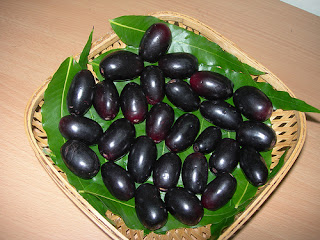Berry Berry Healthy
“Black jamuns” they say are the best cure for
Diabetes, among other ailments.For many of us, the black jammun is best eaten
with a generous pinch of sea salt and a dash of pepper. But there are many
other ways in which this native fruit can be eaten.
Jambul or jamun or jamblang is an evergreen
tropical tree in the flowering plant family Myrtaceae, native of India,
Pakistan and Indonesia. It is now also grown in other parts of southern Asia
including Myanmar and Afghanistan. In Brazil, where it was introduced from
India during Portuguese colonization, it has dispersed spontaneously in the
wild in some places, as its fruits are eagerly sought by various native birds
such as thrushes, tanagers and the great kiskadee.
The fruit is oblong, starts out as green and
turn from pink to shiny crimson to black as it matures. A variant of the tree
produces white coloured fruit .The fruit has a combination of sweet, mildly
sour and astringent flavour and tends to colour the tongue purple. The seed is
also used in various alternative healing like ayurveda (to control diabetes),
Unani & Chinese medicine to cure digestive ailments. The leaves and bark
are used for controlling blood pressure and gingivitis while wine and vinegar
are also made from the fruit.
BUYING BLACK JAMUNS
The jamuns sold in the markets are available
in various sizes. The larger varieties are not necessarily the best ones. Look
for fruits that has a dark, smooth, unblemished skin and is firm to the touch. Although
the soft, pulpy kind is also sweet, make sure the fruit is not overripe.
STORING BLACK JAMUNS
If kept in the fridge, the fruit can last for
a good five days. But they tend to ripen and thus lose much of the flavour.
That is why it is advisable to consume black jamuns the very day you buy them.
NUTRITIONAL VALUE
If you suffer from
diabetes, then this is the perfect fruit for you. It contains the enzyme
jamboline, which helps control your blood sugar level. Another option is to dry
seeds, powder them and have a bit of the powder every day. This will help
regulate your blood pressure.
Nutritional value per 100 g (3.5 oz) Energy 251 kJ (60 kcal), Carbohydrates 15.56 g, Fat 0.23 g, Protein
0.72 g, Water 83.13 g, Vitamin A 3 IU, Thiamine (vit. B1) 0.006 mg(1%),
Riboflavin (vit. B2) 0.012 mg(1%),
Niacin (vit. B3) 0.260 mg (2%),
Pantothenic acid (B5) 0.160 mg
(3%), Vitamin B6 0.038 mg (3%), Vitamin C 14.3 mg (17%), Calcium 19 mg (2%), Iron 0.19 mg (1%), Magnesium
15 mg (4%), Phosphorus 17 mg (2%),
Potassium 79 mg (2%), Sodium 14 mg (1%)Source USDA nutrient
database.

I think this is one of the most important information for me. And i’m glad reading your article.
ReplyDeleteClick here for diabetic gift
Thanx a lot.happy to know u liked it..
Deletethnx..
stay blessed.:)
Thanx a lot.happy to know u liked it..
Deletethnx..
stay blessed.:)
wonderful grapes they look nice
ReplyDeletehttp://sa-sports99.blogspot.com/2012/11/african-cup-of-nations-2013.html
they are not grapes steve..:P
Delete